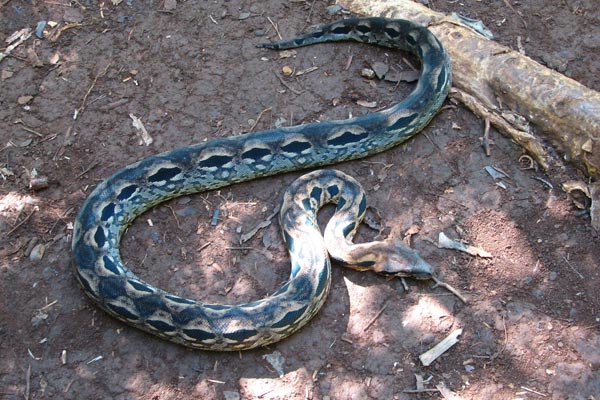Post by Ceratodromeus on Jan 22, 2016 22:10:50 GMT 5

Scientific classification
Kingdom: Animalia
Phylum: Chordata
Subphylum: Vertebrata
Class: Reptilia
Order: Squamata
Suborder: Serpentes
Family: Boidae
Subfamily: Sanziniinae
Genus: Acantrophis
Species: A.madagascariensis
Description
This is a large, terrestrial boid species. They are perfectly adapted for living in the ground cover -- their black, brown, and white body coloration, and the distinctive patterning, helps them blend into the leaf litter perfectly. They are relatively heavy bodied animals, with a strongly triangular head shape. Adults have been measured up to 3.2m(9.8ft) in total length{1}; in recent years, an animal affectionately named "Big George" was captured by reseasrchers and measured. Using a strip of cloth for measuring, these researchers came up with a conservative estimate of 2.7m(8.8ft) in total length, and was found to weigh 8.2kg(18lbs){2}.

Geographic range & habitat use
This species can be found throughout most of the Northern forests of Madagascar, and though not very abundant,(they aren't gregarious, and thus finding them in high densities will not occur. Finding even a single individual is a laborous task), they are an easy species to distinguish as they are the largest snake native to Madagascar. They inhabitat dry deciduous forests,{1,3} often being found near the base of trees, where they will sit perfectly camoflauged, in order to ambush prey. They have even been found in burrows crafted by small mammals, likely having eaten the inhabitants.

Dietary habits
The Madagascan ground boa is a largely nocturnal species, though it can often be stirred form its leaf litter cover during daylight hours. Being nocturnal has its benefit, being a predator, it allows them to take prey that is resting or otherwise unaware due to impaired vision. As they are a large, powerfully built species, the madagascar ground boa can feed on an array of mammals. They are known predators of the lemurs, having being documented preying on adult Coquerel's Sifaka (Propithecus coquereli), Diadmed sifakas(Propithecus diadema) Brown lemurs(Eulemur fulvus), and will also eat smaller mammals such as rodents, or small lizards(Oplurus){1,4,5,6}.

Reproduction
These snakes are viviparous(live baring, with a brood size of 1-8 neonates{1}. Despite their large size, Madagascar ground oars give birth to few offspring; however, these offspring tend to be relatively large, and this is likely the reason for few young being born. In captivity, animals reach sexual maturity at 4-5kg(8.8-11.2lbs){2}.
References
{1} O'Shea, Mark. Boas and Pythons of the World. New Holland Publishers, 2007.
{2} Gardner, Charlie, Naci Germain, and Cédric de Foucault. "Heaviest recorded specimen of Madagascar ground boa."
{3} Labanowski, Robert J., and Andrew J. Lowin. "A reptile survey in a dry deciduous forest fragment in northern Madagascar showing new records for the little-known snake Pararhadinaea melanogaster and a range extension for the skink Amphiglossus tanysoma." Herpetology Notes 4 (2011): 113-121.
{4} Burney, David A. "Sifaka predation by a large boa." Folia Primatologica 73.2-3 (2002): 144-145.
{5} Gould, Lisa. "Lemur social systems and their ecological basis." International Journal of Primatology 17.1 (1996): 153-155.
{6} Headland, Thomas N., and Harry W. Greene. "Hunter–gatherers and other primates as prey, predators, and competitors of snakes." Proceedings of the National Academy of Sciences 108.52 (2011): E1470-E1474.


